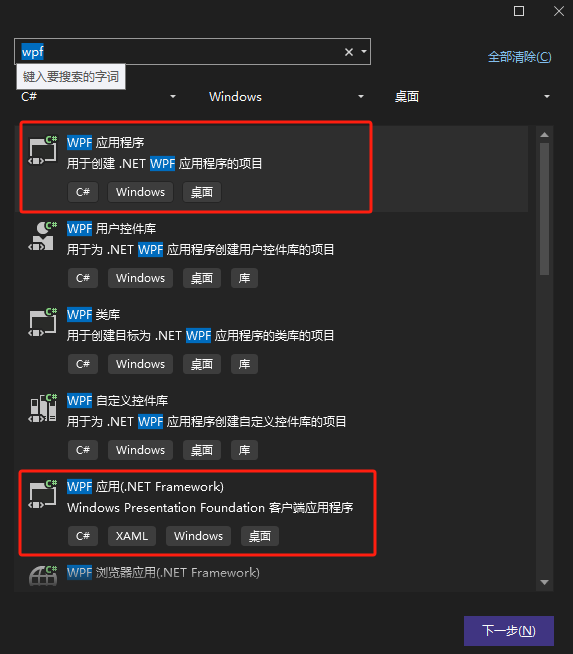WPF利用NotifyIcon创建任务栏图标(菜鸟教程)
学习目标:
记录从WPF应用创建开始,一步步到任务栏图标创建的全过程。流程:
1、环境:Win10 + VS2017
打开VS2017,选择文件 -> 新建 -> 项目 -> Visual C# -> Windows桌面 ->WPF应用(.NET Framework) -> 更改项目名为 TasbarIcon -> 确定

注意:在VS2022中,要区分:WPF应用程序和WPF应用(.NET Framework),两种类型的项目。
WPF应用程序:创建的是基于.NET Core类型的项目,可跨平台,可以使用.NET5/6/7/8等。
WPF应用(.NET Framework):创建的是基于Framework类型的项目,主打Windows上的应用。

2、添加图标类
右键项目 -> 添加 ->引用,找到System.Windows.Forms 和 System.Drawing两个程序集,打上勾添加进去。

双击打开App.xaml.cs文件,在 namespace TaskbarIcon 里面添加图标类代码
//App.xaml.cs
namespace TaskbarIcon
{
public partial class App : Application
{
}
public class myIcon
{
//任务栏图标
System.Windows.Forms.NotifyIcon notifyIcon = null;
public void Icon()
{
//创建图标
this.notifyIcon = new System.Windows.Forms.NotifyIcon();
//程序打开时任务栏会有小弹窗
this.notifyIcon.BalloonTipText = "PalmServer is running...";
//鼠标放在图标上时显示的文字
this.notifyIcon.Text = "PalmServer";
//图标图片的位置,注意这里要用绝对路径
this.notifyIcon.Icon = new System.Drawing.Icon("E:/WPF prroject/WpfApp4/WpfApp4/sheep.ico");
//显示图标
this.notifyIcon.Visible = true;
//右键菜单--退出菜单项
System.Windows.Forms.MenuItem exit = new System.Windows.Forms.MenuItem("Quit");
exit.Click += new EventHandler(CloseWindow);
//关联托盘控件
System.Windows.Forms.MenuItem[] children = new System.Windows.Forms.MenuItem[] { exit };
notifyIcon.ContextMenu = new System.Windows.Forms.ContextMenu(children);
this.notifyIcon.ShowBalloonTip(1000);
}
//退出菜单项对应的处理方式
public void CloseWindow(object sender, EventArgs e)
{
//Dispose()函数能够解决程序退出后图标还在,要鼠标划一下才消失的问题
this.notifyIcon.Dispose();
//关闭整个程序
Application.Current.Shutdown();
}
}
}3、使用图标类
先打开 MainWindow.xaml文件,在里面添加closed事件的声明
//MainWindow.xaml
<Window x:Class="TaskbarIcon.MainWindow"
xmlns="http://schemas.microsoft.com/winfx/2006/xaml/presentation"
xmlns:x="http://schemas.microsoft.com/winfx/2006/xaml"
xmlns:d="http://schemas.microsoft.com/expression/blend/2008"
xmlns:mc="http://schemas.openxmlformats.org/markup-compatibility/2006"
xmlns:local="clr-namespace:TaskbarIcon"
mc:Ignorable="d"
Title="MainWindow" Height="450" Width="800"
Closed="Window_Closed">
<Grid>
</Grid>
</Window>然后在MainWindo.xaml.cs文件里面使用图标类
//MainWindo.xaml.cs
namespace TaskbarIcon
{
public partial class MainWindow : Window
{
public MainWindow()
{
InitializeComponent();
ic = new myIcon();
ic.Icon();
}
myIcon ic;
public void Window_Closed(object sender, EventArgs e)
{
ic.CloseWindow(null, null);
System.Windows.Application.Current.Shutdown();
}
}
}至此,就能创建出自己的程序任务栏图标了!
2025-05-29 15:39:36【出处】:https://blog.csdn.net/A_water_/article/details/114950943
=======================================================================================
WPF 通知栏图标和右键菜单
WPF没有自带的通知栏图标组件,需要引用Windows类库,具体代码如下:
public MainWindow() { InitializeComponent(); icon(); wsl = WindowState.Minimized; } #region 通知栏 WindowState wsl; System.Windows.Forms.NotifyIcon notifyIcon = null; private void icon() { this.notifyIcon = new System.Windows.Forms.NotifyIcon(); this.notifyIcon.BalloonTipText = "ECMS 服务正在运行..."; //设置程序启动时显示的文本 this.notifyIcon.Text = "ECMS 服务";//最小化到托盘时,鼠标点击时显示的文本 this.notifyIcon.Icon = new System.Drawing.Icon("./logo_48X48.ico");//程序图标 this.notifyIcon.Visible = true; //右键菜单--打开菜单项 System.Windows.Forms.MenuItem open = new System.Windows.Forms.MenuItem("Open"); open.Click += new EventHandler(ShowWindow); //右键菜单--退出菜单项 System.Windows.Forms.MenuItem exit = new System.Windows.Forms.MenuItem("Exit"); exit.Click += new EventHandler(CloseWindow); //关联托盘控件 System.Windows.Forms.MenuItem[] childen = new System.Windows.Forms.MenuItem[] { open, exit }; notifyIcon.ContextMenu = new System.Windows.Forms.ContextMenu(childen); notifyIcon.MouseDoubleClick += OnNotifyIconDoubleClick; this.notifyIcon.ShowBalloonTip(1000); } private void OnNotifyIconDoubleClick(object sender, EventArgs e) { /* * 这一段代码需要解释一下: * 窗口正常时双击图标执行这段代码是这样一个过程: * this.Show()-->WindowState由Normail变为Minimized-->Window_StateChanged事件执行(this.Hide())-->WindowState由Minimized变为Normal-->窗口隐藏 * 窗口隐藏时双击图标执行这段代码是这样一个过程: * this.Show()-->WindowState由Normail变为Minimized-->WindowState由Minimized变为Normal-->窗口显示 */ this.Show(); this.WindowState = WindowState.Minimized; this.WindowState = WindowState.Normal; } private void Window_StateChanged(object sender, EventArgs e) { //窗口最小化时隐藏任务栏图标 if (WindowState == WindowState.Minimized) { this.Hide(); } } private void ShowWindow(object sender, EventArgs e) { this.Visibility = System.Windows.Visibility.Visible; this.ShowInTaskbar = true; this.Activate(); } private void HideWindow(object sender, EventArgs e) { this.ShowInTaskbar = false; this.Visibility = System.Windows.Visibility.Hidden; } private void CloseWindow(object sender, EventArgs e) { System.Windows.Application.Current.Shutdown(); } #endregion

2025-05-29 15:54:01【出处】:https://blog.csdn.net/zhumingyan/article/details/51136690
=======================================================================================
[WPF]创建系统栏小图标
隐藏窗体任务栏图标#
/// <summary>
/// MainWindow.xaml 的交互逻辑
/// </summary>
public partial class MainWindow
{
public MainWindow()
{
InitializeComponent();
this.ShowInTaskbar = false;
}
}
系统图标类 #
public class SystemTray
{
public static SystemTray Instance;
/// <summary>
/// 静态构造函数,在类第一次被创建或者静态成员被调用的时候调用
/// </summary>
static SystemTray()
{
Instance=new SystemTray();
}
public NotifyIcon Ni { get; set; }
private SystemTray()
{
Ni = new System.Windows.Forms.NotifyIcon();
Stream iconStream = Application.GetResourceStream(new Uri("pack://application:,,,/StikyNotes;component/MyLogo.ico")).Stream;
Ni.Icon = new System.Drawing.Icon(iconStream);
Ni.Visible = true;
Ni.MouseClick += Ni_MouseClick;
}
private void Ni_MouseClick(object sender, MouseEventArgs e)
{
if (e.Button == MouseButtons.Right)
{
System.Windows.Controls.ContextMenu NotifyIconMenu = (System.Windows.Controls.ContextMenu)App.Current.FindResource("NotifyIconMenu");
NotifyIconMenu.IsOpen = true;
App.Current.MainWindow?.Activate();
}
if (e.Button == MouseButtons.Left)
{
var wins=WindowsManager.Instance.Windows;
foreach (var i in wins)
{
i.Activate();
}
}
}
/// <summary>
/// 销毁系统托盘图标的资源
/// </summary>
public void DisposeNotifyIcon()
{
Ni?.Dispose();
}
}
在App.xaml中:
public partial class App : Application
{
System.Threading.Mutex mutex;
protected override void OnStartup(StartupEventArgs e)
{
bool ret;
mutex = new System.Threading.Mutex(true, "StikyNotesAPP", out ret);
if (!ret)
{
MessageBox.Show("程序已经运行了");
Environment.Exit(0);
}
base.OnStartup(e);
var systemtray = SystemTray.Instance;
}
protected override void OnDeactivated(EventArgs e)
{
base.OnDeactivated(e);
System.Windows.Controls.ContextMenu menu = this.FindResource("NotifyIconMenu") as ContextMenu;
if (menu.IsOpen == true)
{
menu.IsOpen = false;
}
}
/// <summary>
/// 新建窗体
/// </summary>
/// <param name="sender"></param>
/// <param name="e"></param>
private void MenuOpen_Click(object sender, RoutedEventArgs e)
{
var MainWindow = new MainWindow();
MainWindow.DataContext = new MainViewModel(MainWindow, new WindowsData());
WindowsManager.Instance.Windows.Add(MainWindow);
MainWindow.Show();
}
/// <summary>
/// 窗体退出
/// </summary>
/// <param name="sender"></param>
/// <param name="e"></param>
private void MenuExit_Click(object sender, RoutedEventArgs e)
{
SystemTray.Instance.DisposeNotifyIcon();
App.Current.Shutdown();
}
/// <summary>
/// 窗体退出事件
/// </summary>
/// <param name="e"></param>
protected override void OnExit(ExitEventArgs e)
{
base.OnExit(e);
XMLHelper.SaveObjAsXml(ProgramData.Instance, "StikyNotesData.xml");
SystemTray.Instance.DisposeNotifyIcon();
}
private void Application_Startup(object sender, StartupEventArgs e)
{
var programData = XMLHelper.DecodeXML<ProgramData>("StikyNotesData.xml");
if (programData != null)
{
var windowsDatas = programData.Datas;
ProgramData.Instance.IsWindowTopMost = programData.IsWindowTopMost;
ProgramData.Instance.IsStartUpWithSystem = programData.IsStartUpWithSystem;
MainWindow MainWindow;
//有创建过的窗口
if (windowsDatas.Count > 0)
{
for (int i = 0; i < windowsDatas.Count; i++)
{
MainWindow = new MainWindow();
MainWindow.DataContext = new MainViewModel(MainWindow, windowsDatas[i]);
MainWindow.Show();
}
}
else//以前的窗口都被删掉了
{
MainWindow = new MainWindow();
MainWindow.DataContext = new MainViewModel(MainWindow, new WindowsData());
MainWindow.Show();
}
}
//没有创建过的窗口
else
{
var MainWindow = new MainWindow();
MainWindow.DataContext = new MainViewModel(MainWindow, new WindowsData());
MainWindow.Show();
}
}
}App.xaml中
<ContextMenu x:Key="NotifyIconMenu" StaysOpen="False">
<MenuItem
Name="MenuOpen"
Click="MenuOpen_Click"
Header="新建" />
<MenuItem
Name="MenuExit"
Click="MenuExit_Click"
Header="退出" />
</ContextMenu>问题#
记得在退出的时候要释放使用的图标资源,否则在程序退出之后,系统栏中还会存在小图标,要使用下面这条语句:
SystemTray.Instance.DisposeNotifyIcon();
效果#
2025-05-29 15:57:37【出处】:https://www.cnblogs.com/lizhenghao126/p/11053588.html
=======================================================================================
如果,您希望更容易地发现我的新博客,不妨点击一下绿色通道的【关注我】。(●'◡'●)
因为,我的写作热情也离不开您的肯定与支持,感谢您的阅读,我是【Jack_孟】!
本文来自博客园,作者:jack_Meng,转载请注明原文链接:https://www.cnblogs.com/mq0036/p/18902717
【免责声明】本文来自源于网络,如涉及版权或侵权问题,请及时联系我们,我们将第一时间删除或更改!






 浙公网安备 33010602011771号
浙公网安备 33010602011771号